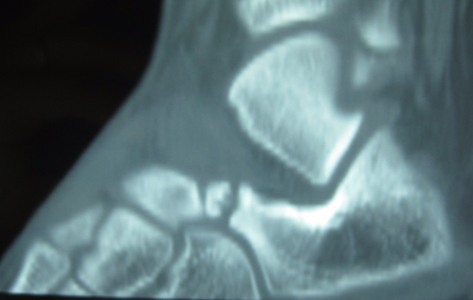A tarsal coalition is an abnormal connection between two or more tarsal (hindfoot or back of the foot) bones and can be classified into osseous (boney), cartilaginous (synchondrosis), or fibrous (syndesmosis). This union may be partial or complete and the joints involved typically lose their normal motion. It usually causes a flatfoot deformity with associated stiffness. Oftentimes if is noticed around adolescence.
Office Appointments and Telemedicine with Dr. Carreira

You can also book an office appointment or a telemedicine visit by calling Dr. Carreira’s office at 404-355-0743. Book now.
Tarsal coalitions typically cause pain in the area of the foot and sometimes the ankle although patients may not necessarily notice it because the range of motion loss can be limited to the back of the foot only. Especially as patients get older, tarsal coalitions are associated with the development of arthritis.
The proper diagnosis can be made with physical examination and includes imaging studies such as x-rays, CT scan, or MRI. Nonoperative treatment, including rest, immobilization, orthotics, and medications, typically is started after the diagnosis is made. Most patients need surgical treatment.
Two main options are recommendable for surgical treatment:
- Removal of the abnormal connection with placement of tissue or bone wax in between the bones, or
- A fusion procedure.
Removal of Tarsal Coalition
Removal of the abnormal connection between the bones of the hindfoot is moderately successful in the long-term. Improvement in motion varies across patients, and range of motion exercises after surgery is important to maximize motion in the back of the foot. The main goal of surgery is pain relief. The success rate with this procedure is lower for talocalcaneal coalitions as compared to other coalitions.
Fusion (Arthrodesis)
Fusion of the two bones across which the coalition exists is also an option. Several factors are considered as to whether a patient should have a fusion procedure done as compared to removal of the coalition, including age, desired activity level, extent of coalition, type of coalition. With fusion procedures, the recovery consists of an extended period of non weight-bearing, typically 6 to 8 weeks.
Recovery for Removal of Coalition
You will be placed into a bulky splint on the day of your surgery.
You are to use crutches and avoid weightbearing on your foot until the first visit after surgery, typically 10 days later.
Assuming that you drive an automatic car:
If surgery was on your left foot, you may drive as soon as you are not using narcotics. If surgery was on your right foot, you may start driving as soon as your bulky splint has been removed. For driving you will need a postoperative shoe, only to be used for driving and sleeping. Test your driving in a parking lot first.
Specific Post-Operative Course for Removal of Coalition
Day 1
- Foot wrapped in bulky bandage
- Ice, elevate, and take pain medication
- Expect numbness in the foot for 12 to 24 hours
- Expect bloody drainage through bandage. You may add to the dressing, but do not remove it
Day 10
- First follow-up visit
- X-rays will be obtained in the office
- Sutures likely removed
- Start walking in a CAM walker boot
- Ice and elevate as much as possible
- Shower as long as the incision is healed
6 weeks
- Wean from CAM boot
- Increase activities including gradual increase in exercise




